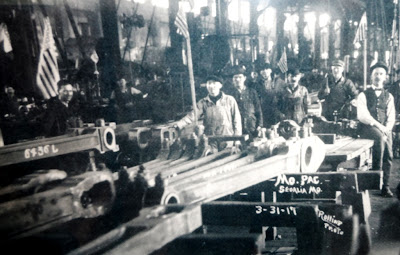While we attended the Escapees RV Rally in Sedalia, MO, we also took time to explore around the town and learned that the city owed much of its growth to the railroad.
The first railroad line reached Sedalia in 1861, shortly after the city's founding in the late 1850's. Soon after, the Missouri, Kansas and Texas Railroad (also known as the KATY) also entered the city (in about 1870) and ended up building this fabulous depot in 1896. Today, the depot serves as a museum featuring the railroad history of the area.Rick visited the depot with friends Denise and Butch, who also were attending the Escapees Rally (I guess that makes us all escapers).
We really enjoyed the museum's exhibits and information on the past. Here, Rick checks out some of the typical railroad items that were so common not so long ago.
Due to Sedalia's central location, both the KATY and Missouri Pacific Railroads established large locomotive repair and construction shops. Here, an aerial view of the Missouri Pacific lines large facility in downtown Sedalia in the 1920s shows the size of this installation.
These shops, employing hundreds of machinists and other workers like these men, could literally build a locomotive from scratch. They could also totally rebuild one if needed. Here, they are working on the rods that connect the driving wheels together.
This locomotive is typical of the large engines that roamed the rails around Sedalia. Now displayed at the Fairgrounds in Sedalia, Rick was able to see this one every day at the Rally since it was right next to the free coffee stand!
Sedalia grew rapidly with the two railroads running through the city as this picture of downtown in 1890 shows. The railroad also provided a target for large cattle drives from Texas in the late 1800's. The combination of railroad workers, cowboys and the like also caused Sedalia to have a thriving "red light" district with the city being referred to as the Sodom and Gomorrah of the Nineteenth Century.
The city was quite the active spot not only for railroads, but also for livestock, such as these mules that Missouri (and Sedalia) was famous for. These four sold for over $7,300 in 1909 -- a huge sum of money for the time!
Today, Sedalia still offers many things to see, although the railroad has a very small presence. The locomotive shops are all gone and Main Street is pretty much deserted. In fact, as we drove down it, we saw this collapsed building that may have been built back in the city's heyday. Bet it would have had some great stories to tell if it could have talked.






















































